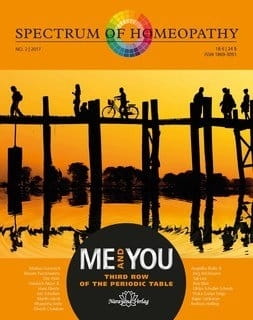Me and You - Spectrum of Homeopathy 2017/2
This issue of SPECTRUM will surprise its readers because it offers an abundance of new findings and discoveries about the very well-known remedies such as Natrium (Sodium), Sulphur or Phosphorus. Many elements and compounds of the Silica series have already been examined by Hahnemann and used successfully to this day in homeopathic practice. However, astonishing new perspectives are revealed when these polychrests are considered systematically, theatrically or on the level of sensation in addition to the Materia medica. Our authors analyse the remedies of the 3rd series on the basis of the Periodic Table of Elements, which have been translated into human developmental periods, phases and stages by Jan Scholten.
“Me and You” is the comprehensive theme of the 3rd series. According to Jan Scholten, the Silica series corresponds to the life phase of a teenager with the main theme of relationships within the family and with friends. In addition to the body-oriented “I” of the Carbon series, in the 3rd series we come into contact and communication with another person who we want to like us, who we love or who we hate. The position that we assume within a relationship and the feeling of belonging to a group, characterise the respective level in the development with regard to the other person. In his analysis, Scholten writes about these phases of the Silica series and shows parallels to the plant world, as Martin Jakob explains in greater detail in his article.
With his case examples on the salts ranging from Natrium (Sodium) to Sulphur, Markus Kuntosch provides an overview on the development of the relationship theme. This spectrum becomes especially clear when we – like Renate Paschmanns – consider the two poles of Natrium (Sodium) and Argon.
Homeopaths who work according to Rajan Sankaran place a different accent on the systematics in the Silicia series. In terms of developmental psychology, Sankaran sees the 3rd series in the preschool age, which is when the child begins to make independent decisions. The topic is also “Me and You” here, but the focus is on developing the identity. Bhawisha Joshi demonstrates this in her overview article and contributes her ideas of an organising periodic system that also applies to the plant and animal world.
The process of finding an identity is concentrated in the statement of “I want to be like you” for Natrium (Sodium) (Jörg Wichmann / Angelika Bolte) and “I am not you” for Phosphorus (Rajan Sankaran). This allows us to understand the elements of the Silicia series in a new way: Dinesh Chauhan does this for Nat-mur., Tali Levi for Nat-s., Bob Blair for Mag-s., Ose Hein for the other magnesium salts and Wyka Feige for the compound of magnesium and silica in soapstone. The identity question of “Who am I?” also receives some completely new, surprising aspects in Ulrike Schuller-Schreib’s exciting study of aluminium: even in its unclear position within the periodic system, Alumina’s well-known confusion about an individual’s identity becomes evident.
SPECTRUM also offers a very special new feature. For the first time, Andreas Holling has published his Dimensions Model of the Periodic System. Andreas has spent years in the development, polishing, testing and use in practice of his Dimensions Model of the Periodic System. This has resulted in the inclusion of the sensation level of the minerals, for the first time.
- Author: Narayana Verlag
- ISBN: No ISBN
- 120 pages
- Paperback
- Published in 2017
- Printed in Germany

